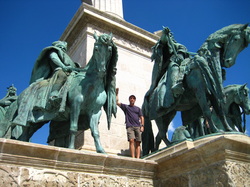
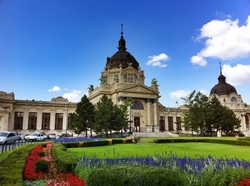
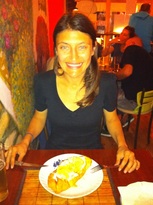
The next stop on our journey was an extended layover to Budapest, taken as the most expedient way to meet our friends Tom & Amy down in Croatia. As we took a walking tour of the city, we admired the Hapsburg era architecture on Castle Hill and along the Danube River separating Buda from Pest. Budapest is full of beautiful buildings – from the Parliament building to the Opera House. They also have the oldest underground in Continental Europe (2nd in age only to London in the world), built during the glory days of the late 19th century when the country was celebrating its millennial anniversary.  A tribute to the Magyar tribes The anniversary marks the year the 7 horse riding Magyar (Hungarian) tribes arrived in the Carpathian Basin that is present day Hungary in 896. Neda and I saw some parallels with Bulgaria here, as the Bulgars who rode into early Bulgaria were an Asiatic horse riding people as well. The Bulgars were a minority compared to the Slavs of the region (the Slavs allowed them to govern due to their ability to protect the population from the Ottoman Empire) and eventually many of their customs were assimilated with Slavic ones. In the case of Hungary, assimilation came as a result of the Mongol Horde that attacked the country in the 13th century, decimating an unbelievable half of the population. When the Mongols were finally forced out, the Hungarian crown had to repopulate their country with the peoples of surrounding areas – thus the reasons Hungarians do not appear Asian in origin.  The Szechenyi Baths Though the Mongols were a devastating time in history for Hungary, its successive invaders would prove to be much more gracious than Bulgaria enjoyed. The inevitable invasion by the Ottoman Empire lasted only 150 years in Hungary as compared to 500 in Bulgaria. The Turks didn’t destroy the churches in the city of Budapest, but instead repurposed them as Mosques. They also left behind the culinary legacy of Hungarian Paprika and the vibrant tradition of the Turkish Baths, which built upon the fact that Buda is a hotspot of natural mineral springs along the Danube. The Turks were forced out of Hungary by the conquering Habsburg Empire in 1686. But the mid 19th century, however, Hungary had managed to establish a dual monarchy that made Budapest a 2nd capital of the empire alongside Vienna. This stability led to unprecedented growth during which time such architectural marvels as the Parliament Building and underground line were constructed. All this is not to say that Hungary has had an easy history. But its beginnings have an interesting similarity to those of Bulgaria that diverge due to Bulgaria’s proximity to Turkey and its distance from Western Europe. There was no Habsburg empire to bail Bulgaria out of 500 years of oppression by the Ottoman Empire and no relief from the 50 year reign of censorship that Communism brought. The result left us wondering how Bulgaria might have looked if it had been located further north on the continent. Would it have retained more of its architecture, most of which now is just communist style concrete slop? Of course such questions are pointless as Bulgaria’s very identity is irreparably entangled with its invaders. But then again so is Hungary’s, only their invaders left behind a bit of beauty with their destruction.  Our pitstop in the city was lucky enough to coincide with the Sziget festival – a week long mega festival on an island in the middle of the Danube that brings in huge acts from around the world. We danced the night away with LMFAO, Beardyman, and the Killers. With over 300,000 people in attendance the event could only be described as one hot mess. But fun for a day! Lots of partying and too many langosh’s (a Hungarian specialty comprising of a circular piece of fried dough topped with garlic, cheese, and sour cream - Neda had one with chicken paprika on it pictured here) made our stomachs ready to leave Hungary as we headed down to Crikvenica) to meet up with Tom & Amy!
0 Comments
“Why leave behind the seat in your own home to wander in vain through the dusty realms of other lands? If you make one misstep, you stumble past what is directly in front of you.” The above quote from Dogen’s Fukanzazengi so accurately depicts my feelings as we traveled through Bulgaria with our friends Brett and Christie. Dogen, of course, is referring to the fact that the wonder of the present moment is available to us no matter where we are and that it can be folly to think that happiness lies in traveling to new lands. Yet we recognize that travel is a wonderful way to challenge engrained habits and finding living ways to connect to the present. Still, Dogen’s words echoed through my head as we returned to Bulgaria to show its beauty to our friends. We visited some sites we have seen before and some that we haven’t, but each site brought more wonder and awe than most we have seen around the world. My appreciation of the wonders of my home grows with each step I take through it. 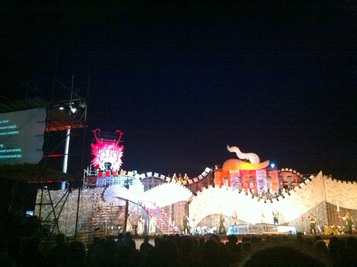 Turandot at the ruins Our first stop was Veliko Tarnovo, the old capital of the Second Bulgarian Empire. We have been there many times before, but through travelers' eyes the city and its ruins appeared even more beautiful and majestic than before. As we waited for our friends’ bus to arrive, we happened to stumble upon a free opera presentation of Turandot right in the heart of the ruins of the old city of Tzarevetz. The ringing voice of the singer portraying Prince Altoum was mesmerizing as it carried through the ruins of the ancient city, bringing a life to the place that has been absent for centuries. This was one of the top experiences of our travels! 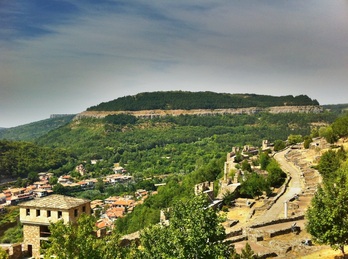 Views of Tzarevetz from the tower We explored the new city of Veliko Tarnovo and the old ruins with Brett and Christie the next day as we began to introduce them to traditional Bulgarian foods and drinks. As vegetarians, they were thankful to discover the fresh vegetable salads that crowd the menus here. They also loved Bulgarian tarator, a cold summer soup of yogurt, cucumbers, garlic, dill, and walnuts. We took a short trip up one of the hills to visit the small village of Arbanasi, where many 18th century homes have been preserved and some serve as museums. To see pictures of this leg of the trip, click here. Our next stop was Stara Zagora, where I have spent the majority of my life. My mom prepared delicious vegetarian versions of Bulgarian dishes and we shared our gardens’ veggies and fruits with our guests. We took them to see the famous Shipka Monument, dedicated to those who died in the Liberation of Bulgaria at Shipka pass. Shipka is sort of like the Bulgarian “300”, where 7,500 Bulgarian and Russian soldiers defended the pass against nearly 40,000 Turkish soldiers during a grueling winter campaign. The views from the top uncovered rolling hills of limitless mountains and peaks. (Pics for Shipka here). We could also see Buzludja perched atop its mountain, our next stop of the roadtrip. This ruined Communist monument was fascinating and deserved its own blog post; you can read about it in our previous post. Of course any trip to Stara Zagora with the Fields’ isn’t complete without the mandatory tour of the Zagorka brewery and the ensuring hilarity. Even though the brewery was bought by Heineken back in the 90s, it is still the area’s beloved local beer, and the brewery remains the only place you can taste their fresh 6.4% probiotic packed live beer at the end of the tour. As sometimes happens with Bulgarian hospitality, the 30 min tasting session turned into 1.5 hours and many smiles as it did when our friend Ryan came to visit last November. Check out the rest of the pics here. With dad driving our caravan, we set off to the south western part of the country where the smallest town in Bulgaria lies - Melnik. Most of the town’s buildings are preserved cultural monuments indicative of the life of the people here a couple of hundred years back. 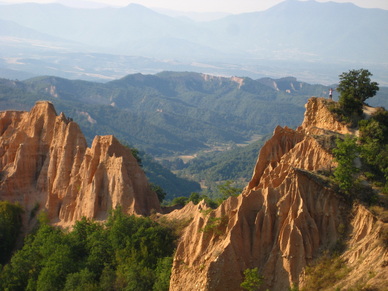 The beautiful sand formations According to archeological evidence, the Thracian tribe Medi first settled this area and interestingly enough, Spartacus belongs to this tribe! The city is surrounded by unusual and unique sand formations called the Sand Pyramids. As we hiked up the pyramids in the early morning, we were awed by the glowing rocks and delighted by the panoramic views of this part of the country. We ended our hike at the Rozhen Monastery, the biggest monastery in the Pirin Mountains. Melnik also offered a variety of wonderful foods, including the tasty Greek fish Tzipura (Sea Bream) and unique wines from the region. Christie arranged for us to visit a winery, Villa Melnik, which turned into an afternoon of hospitality and generosity by the owner, Nikola and his vintner Didier Mailhe. While his new larger wine making facility was not fully completed yet, Nikola still graciously took us on a tour of the building and showed us every detail of how the wine will be produced here. He also took us out in the vineyard, where he plucked handfuls of different varietals and let us try them all! He then invited us into his home, but not before taking us to visit a local rakia distillery, where Brett & Christy could see this authentic Bulgarian spirit being made under the hot Melnik sun! Back at Nikola’s home, Didier led the tasting as bottle after bottle of Villa Melnik’s best were uncorked. Each bottle was more delicious than the next and most had won medals at the International Winery Exhibition in Plovdiv. One of our favorites was the spicy and bold Melnik 55, a red made with the local grape of the region. Thank you Villa Melnik for such a memorable experience!! Pics from Melnik are here. En route to our next destination, we stopped to see the famous Baba Vanga monastery, where we chillaxed, slacklined, and enjoyed the peaceful space she had created. We also took a hike in the Pirin mountains and visited its largest waterfall. Pics of this day trip are here. 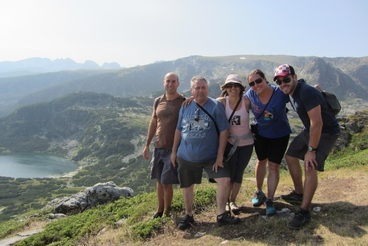 The crew with fish lake in the background Our next big adventure lay in the Rila Mountains, home to the infamous Seven Rila Lakes. We took a lift up to these high altitude lakes, which were formed by melting glaciers many years ago. Each lake is named after its main characteristic such as the Tear for its clear waters, the Eye and Kidney for their shape, the Twin, the Trefoil, the Fish, and the Lower lake in order of their location and height. Even from the lift it is another 3 hour hike up to the highest peak, which rewarded us with an inspiring view of the Rila Mountains surrounding these mystical lakes. The crystal clear waters of the lakes serenely reflect the surrounding peaks and imbue peace to the observer. Some believe they represent the Seven Chakras from the yogic traditions and it is easy to understand why as the 7 lakes are all connected by the “spine” of flowing waterfalls. There is even a religious sect called the Dunovisti, that spend the whole month of August performing ecstatic dancing in a series of concentric circles close to the lakes as they commune with God and nature. This amazing natural phenomenon is one of the most beautiful we have seen from anywhere in the world. I couldn’t help but smile as I recalled Dogen and wonders that lie “in the seat” of my own home. See all the beautiful shots of the Rila Lakes here. For our last evening, we arranged to spend the night at the Rila Monastery, one of the most visited and beautiful monasteries in Bulgaria. We enjoyed our bottles of Villa Melnik wine and fresh trout from the Rila River for our last dinner with Brett and Christie. As the peaceful chatter of the river put us to sleep I heard one of my favorite ATB songs in my mind and realized that I couldn’t have dreamed a better trip through my homeland. I feel the crunch of glass beneath my feet. The echoes of voices wafting from the central chamber. The crumbling murals now decorate the floors as much as the walls. The air harkens back to a time of pride and memory but is singed with the heat of anger. 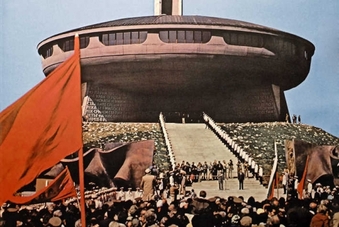 Buzludja in glory days I am walking through the former House-Monument of the Bulgarian Communist Party, named now simply for the mountain upon which it perches - Buzludja. The construction for the monument was finished in 1981 as a 90 year commemoration to the meeting in 1891, where socialist revolutionaries met atop Buzludja to form the foundations of what would later become the Bulgarian Communist Party. But just as meaningfully, the monument was also meant to mark the 1300th anniversary of the foundation of the first Bulgarian Empire in 681 AD. At the time, the site cost a whopping 16 million levs to build (the equivalent of about $10 million dollars in 1980), much of it through “suggested” donations from the Bulgarian people. It took 6,000 workers 7 years to build, and involved 20 leading Bulgarian artists who worked for 18 months on the interior decoration. But after only 8 years as a functional monument, the end of communism in Bulgaria saw Buzludja turned over to the new state, where it was left to ruin by the elements and looters. In 2011, the monument was turned over to the Bulgarian Socialist Party, who promptly welded shut all the entrances, declaring it dangerous and unsafe to enter (which it is). We visited Buzludja as part of a tour of Bulgaria for our friends Brett & Christy, who we met in Thailand. When you first arrive, you can’t help but be stunned by the site of the UFO-like monument perched above the mountain. Its remote location made it an architectural and engineering feat for any time period. Bulgarians tell stories about how at first prisoners were made to work on the monument, then the military joined in, and eventually many volunteers were inspired to help. Abutting the main spherical chamber is a massive concrete tower with a 45 meter high red star embedded in the side. The star is 3x larger than the one at the Kremlin. It is said that when Buzludja was still operating and the star was lit, you could see it from many miles away…though all the electricity of constantly heating the building and lighting the star would often leave local villages in the dark. The star was also rumored to be made of real rubies…a rumor proven untrue when after the fall of communism some people shot machine guns at the stars and received only ruby colored glass in return. 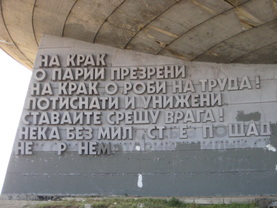 On your feet you slaves of labor... On the street and next to the walking path leading up Buzludja, are two enormous sculpted hands holding torches, keeping guard over the monument. After you take the steep climb up the hill to the monument, you reach the square at the entrance to the building where the party would have held gatherings. Written in giant Cyrillic letters on either side of the doorway are the lyrics to the International Communist Hymn that was sung by communists of all nations during the time of Soviet rule. That would have been it for our visit, but we were lucky enough to run into an intrepid individual who runs tours through Buzludja for visitors. He found an underground entrance near the building where, with the aid of a rope, one can repel down into the ruins. Despite our reservations, we were yearning to see this chapter of Bulgaria’s past, so we grabbed hold and followed them into the darkness…. 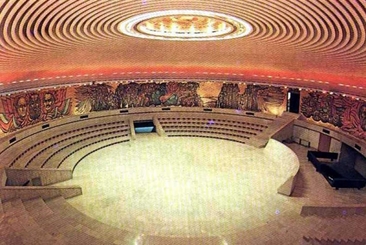 ...and then. Moving through dark corridors…the musky scent of dust and degradation. Climbing the steps towards the light and arriving to a scene of…utter grandeur. Despite the looting and elements, the central chamber of Buzludja is still an awe-inspiring one. The huge spherical chamber is covered in communist styled murals, culminating in a huge hammer and sickle at the ceiling surrounded by a call for the Proletariat in every country to unite. Little remains of the floor, which is said to have been pure marble, or the roof of the sphere, which is said to have consisted of over 30 tons of copper. But many of the murals, in varying states of decay, remain. Of particular note is the mural one sees just upon entering the main chamber. In the center is the face of Dimitar Blagoev, known as the founder of Bulgarian socialism. To his right is Georgi Dimitrov, an early Communitist politician who led Bulgaria from 1946 to 1949. But most interesting is the shadow of the image to the left. Here, the tiles of the face of Todor Zhivkov have been carefully removed, leaving only the outline of his visage. Zhivkov was the President for nearly the whole tenure of communism in Bulgaria – from 1954 to 1989. His missing face is a mystery – either removed by angry protestors after the fall or removed by the man himself when he no longer wanted to be connected to a fallen regime. 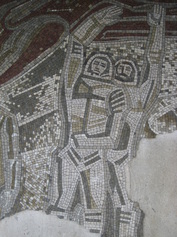 The astronauts The murals are more than just communist leaders. Walking around the outer chamber with its Enterprise-like windows offering sweeping views of the surrounding area, there are celebrations of the Soviet astronauts who first entered space. There are murals commemorating the workers who built the monument. There is even a mural of a Slavic God (perhaps Pirin or Stopan) standing in the middle of the field as the Russian Army liberates (or invades based on your perspective) Bulgaria. Sadly, that last mural was in such a state of decay that it was barely recognizable – this picture from the old times shows what it once resembled. 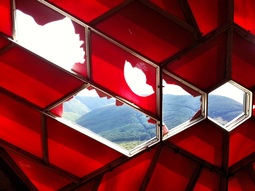 A view through the star As we left the central chamber, we climbed the 10 stories of ladders in the dark to reach the top of the tower where the grand red star lies, still shattered from the gun fire of 20 years ago. The red light shining through the glass casts an eerie glow on the rusty equipment lying around. Sitting anachronistically on one floor was a modern spotlight, probably used by the Socialist party recently in commemoration of their founding. Finally, we emerged at the top of the tower where the stunning view of the countryside, the remains of the roof of Buzludja, and the hillside monument of Shipka takes one’s breath away. 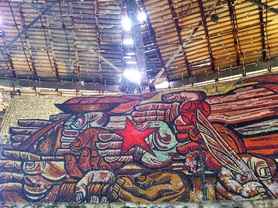 The state of Buzludja left Neda and me with mixed feelings. The site of this great architectural wonder of Bulgarian history being left to ruin filled us with sadness. As we moved through the abandoned halls, it brought to mind the lineage of teachers we are connected to in the Zen tradition. The lineage moves through our teacher, Barbara Kohn, through one of the founders of American Zen Buddishm, Shunryu Suzuki, and eventually down to the Buddha himself. In some ways it is strange for Zen, which focuses so much on the present moment, to emphase a lineage that flows backwards into the past. How do these concepts reconcile? For me, it is the understanding that even while living fully in the present moment, one is always affected and influenced by the stream of past actions. In the case of Buzludja, it felt like Bulgaria’s lineage had been broken. The time when communism dominated the country was a struggle for many ordinary citizens and left behind much resentment. At the same time, this period of history is still part of Bulgaria’s past and shapes who she is today. Should it be left to just fall apart? In 2011, when Buzludja was returned to the Socialist Party in Bulgaria, Bulgaria’s Prime Minister Boyko Borisov said, “We shall let them take care of it because here it also holds true that a party which does not respect its past and its symbols has no future”. 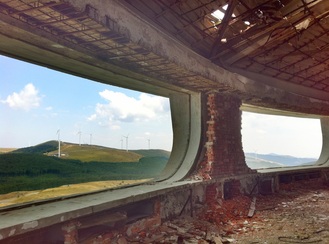 Through old windows, new wind turbines... But is Buzludja only a symbol of the party? Or is it also a symbol of the millions of hours of work that went into constructing it by the Bulgarian people? Isn’t it the inheritance of every Bulgarian citizen to remember not only the pain of their people during this time, but also their spectacular workmanship? It is clear that there is interest. While we visited the site, a steady stream of Bulgarians and foreigners visited, though most were not able to enter the way that we did. Perhaps in some way Buzludja as a ruin presents more allure than it ever could have as a shiny tourist attraction. Perhaps it is the very degradation of the place that serves as such a powerful symbol. Rumors are circulating that the Socialist Party might try to renovate the building if the funds can be raised. It would be an auspicious task to undertake given Buzludja’s current condition, but perhaps it would help to restore a part of the country’s lineage that is being lost even as we speak. To see more pictures of Buzludja taken during our visit, go here: http://flic.kr/s/aHsjBiuiX1
A special thanks goes to Timothy Allen and Darmon Richter, whose previous visits to Buzludja and the blogs they wrote about it helped to inform the history presented here. Check out their wonderful accounts of Buzludja, including Timothy’s visit in the middle of a snowstorm, here: http://humanplanet.com/timothyallen/2012/02/buzludzha-buzludja-bulgaria/ http://bohemian-blog.blogspot.com/2012/04/urban-exploration-communist-party.html |